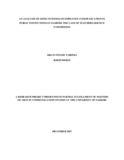| dc.contributor.author | Mbati, Winnie T | |
| dc.date.accessioned | 2018-01-24T06:00:52Z | |
| dc.date.available | 2018-01-24T06:00:52Z | |
| dc.date.issued | 2017 | |
| dc.identifier.uri | http://hdl.handle.net/11295/102630 | |
| dc.description.abstract | This study sought to analyze the effectiveness of employee communication in public institutions in Nairobi with TSC as a case. The objectives of the study were: to analyze existing employee communication tools; to evaluate the effectiveness of employee communication tools; and to investigate the challenges facing employee communication at Teachers Service Commission. The study adopted the Systems Theory to explain the relationships between the variables. A descriptive research design was used to accomplish the research objectives. Both qualitative and quantitative data were used in the study. A sample size of 310 respondents was selected using Fishers (1995) formula. A semi structured questionnaire and interview guide were used to collect quantitative and qualitative data respectively. Reliability and validity of the data were examined using pilot test. Content analysis was done to analyze qualitative data. Percentages and frequencies were used to summarize data into meaningful form. The study findings were presented in tables and charts. Conclusions were drawn from the study findings and recommendation and suggestions for further studies made. The study findings indicated that existing employee communication, effectiveness of employee communication and challenges facing employee communication significantly affected the effectiveness of communication in public institutions. Common channels of communication used by Teachers Service Commission included circulars, website, and memos. Employees found circulars and memos more convenient and effective modes of communication compared to the other modes. Notable challenges of communication were mainly barriers occasioned by lack of direct connection to the organization‟s top executive by employees. The study recommended inclusion of face-to-face communication in passing of information, use of telephone calls which are effective but not used often be incorporated as an official channel and creation of personalized information base with each of its members who have access to mobile phones that they use on daily basis. The study recommends that similar studies should be conducted in other public institutions and across other counties and also in private institutions to increase knowledge on effectiveness of employee communication in organizations in Kenya. | en_US |
| dc.language.iso | en | en_US |
| dc.publisher | University of Nairobi | en_US |
| dc.rights | Attribution-NonCommercial-NoDerivs 3.0 United States | * |
| dc.rights.uri | http://creativecommons.org/licenses/by-nc-nd/3.0/us/ | * |
| dc.subject | An Analysis of Effectiveness of Employee Communication in Public Institutions in Nairobi | en_US |
| dc.title | An Analysis of Effectiveness of Employee Communication in Public Institutions in Nairobi: the Case of Teachers Service Commission | en_US |
| dc.type | Thesis | en_US |



